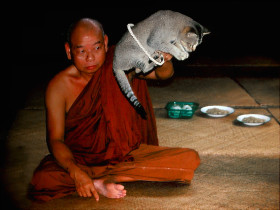Jumping Through Buddhist Hoops in Burma
Posted on 30. Aug, 2010 by Paul Sochaczewski in Curious Travel

INLE LAKE, Burma
“Come on Brochette, jump through this hoop. Arnold Schwarzenegger can do it – it can’t be that hard.”
My friend’s ginger cat in Geneva was doing what cats everywhere do – exactly what she felt like. Which at this moment was not jumping through a hoop.
I was trying to accomplish a similar coup de persévérance to that which some monks in Burma have achieved. Teaching cats parlor tricks. But Brochette wasn’t buying it. What did the monks have that I didn’t?
Lots of patience and an abundant supply of Friskies, as it turned out.
I was introduced to the famous Burmese jumping cats at the Nga Phe Kyaung monastery, on Inle Lake.
The “jumping cat monastery” is a key stop for the trickle of tourists who visit Burma. There I met Venerable U Nanda, 25, one of a dozen resident monks.
“It’s easy to train cats,” he said, somewhat reluctantly putting down his Burmese comic book. With a large dose of ennui he explained that you simply start when they’re kittens, scratch them under the chin, say kon, and reward them with kitty treats.
Obviously, it works. Every 30 minutes or so, when a group of visitors would accumulate, San Win, an assistant in the monastery, would put the cats through their paces.
“What’s that one called?” I asked, pointing to a black and white tabby.
World-weary U Nanda explained “That’s Leonardo di Caprio.”
“And this one?”
“Demi Moore.”
“Can I try?”
I held the wire hoop, in front of Arnold Schwarzenegger,” paradoxically one of the skinnier cats in the temple. I gave him a little nudge, ordered him to kon, and after he jumped I rewarded him with a biscuit.
Meanwhile Tina Turner was curled up on my backpack, asleep. “Don’t leave your things on the floor,” U Nanda instructed. “She pisses everywhere.”
After a while U Nanda started to open up. Perhaps he saw that since I wasn’t going to go away he might as well have a discussion. I was interested in Buddhist history, he was interested in conjugating English verbs.
Throughout our conversation, the abbot, Sayadaw Kite Ti, 68, kept his distance and read a book. I don’t read Burmese, but from the pictures of cowboys and horses I could be pretty sure that it wasn’t a religious text. He didn’t glance up as visitors stuffed relatively generous contributions into the offerings boxes.
A few days later, I trekked an hour up a butterfly-enhanced forest path on Mount Popa, arguably the most mystical hill in this most mystical of countries, to visit a hermit monk named Venerable U Sumana..
Hesitantly, I approached the cave and saw a young monk preparing a fire. I asked if I was disturbing him. Popping in unannounced suddenly seemed like a stupid idea — the last thing I wanted to do was get in the way of his accumulation of karma points. Nevertheless, for a recluse, U Sumana was remarkably outgoing. He had finished his morning prayers, he explained, and invited me to sit on the ledge and chat.
Venerable U Sumana took over the cave that had been the home of U Germany, a legendary monk who meditated in this damp, isolated ledge for 50 years. U Sumana had few possessions, few clothes, and his diet consisted of a handful of rice and some vegetables. To me such isolation, deprivation and rigor would be purgatory. I like my diversions too much – Beethoven, a fine wine, golf, pizza, and the company of friends. U Sumana though had a different view of his adopted home. “It’s shady and cool. It’s easy to get water. I’m in the middle of nature and there’s no one around to distract me from my prayers.” He had bright eyes and an easy smile. He explained he had seen this cave in a dream, and journeyed here from distant Mon state.
My rational, Cartesian mind was racing. “But what do you do all day?” I asked.
Venerable U Sumana, 30, explained simply: “I meditate.” Sometimes sitting. Sometimes walking. He showed me his walking meditation. Very, very slowly, I tried to replicate his movement – I roll from my heel to the toe and hold the opposite foot in the air before placing it down. I concentrate on the action. He explains that this type of practice, called zingyan shouk chin, will clear my mind. Help me to develop patience. Just like training a cat, perhaps.
Back at Inle Lake I sought out U Nanda. I felt I had unfinished business with the young monk, a feeling that there was more to him than a saffron-robed feline-inclined impresario.
“You again,” he said when I walked in. He wasn’t hostile, but he wasn’t overly welcoming.
I deliberately avoided the handful of curious visitors watching Brad Pitt and Michael Jackson leaping about on the linoleum. “Tell me about the temple,” I asked. And he did. He showed me around the 160-year-old monastery, the oldest on Inle Lake. Proudly, he turned on lights so that I could better see the six two-meter tall Buddha images made out of lacquerware, and the gilt-encrusted wooden statues and carved pillars. He took me into the abbot’s room to show me old, sacred Buddha images. In half an hour of looking through different eyes, the monastery for me had evolved from a tourist site into a combination art museum and place of worship
“What do you do?” he eventually asked me.
“I’m a journalist.”
“Then tell people the monastery is more than cats. It’s Buddha.”
